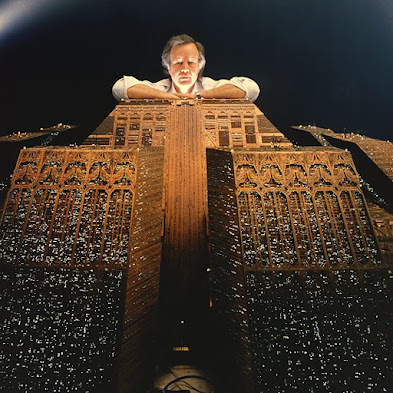Douglas Trumbull with one of his most famous creations, the Tyrell Corporation Headquarters Building from Blade Runner (1982)
Trumbull was born in 1942, the son of Donald Trumbull, an earlier pioneer in Hollywood vfx who had worked on The Wizard of Oz in 1939. Unsurprisingly, Trumbull grew up enamoured of movies, particular science fiction films and movies involving aliens. He studied to become an architect and illustrator but side-lined in to movie vfx when he was hired to work on informative films for NASA and the US Air Force. His work for NASA, as part of Graphic Films, attracted the attention of Stanley Kubrick and he was one of a number of Graphic Films illustrators hired to work on Kubrick's film 2001: A Space Odyssey. When Kubrick moved production to the UK, Trumbull quite his job at Graphic Films to follow the production. Trumbull developed a solid working relationship with Kubrick, leading to him delivering arguably the film's crowning vfx achievement, the depiction of the Stargate sequence at the end of the film.
Despite the boost to his career from working on 2001, Trumbull found the experience of working for a perfectionist like Kubrick draining. Returning to Hollywood, he set up his own effects company and worked on The Andromeda Strain (1971), where he established a good working relationship with Robert Wise. He then directed his first feature film, Silent Running, which partially developed out of his frustration at not being able to realise the planet Saturn convincingly for 2001 (resulting in that movie switching its location from Saturn to Jupiter, famously too late for Arthur C. Clarke to change it in the accompanying novel). The "agro-ships" developed for Silent Running became a very popular design, and were redeployed several years later as part of the rag-tag, fugitive fleet in the original iteration of Battlestar Galactica (1978-79). Trumbull also worked on the TV series The Starlost (1973) as producer and vfx advisor.
Trumbull developed further projects as a director, but his career in that field stalled after Silent Running failed to make much of a dent at the box office. He returned to vfx work, first with The Towering Inferno (1974) and then for Steven Spielberg on Close Encounters of the Third Kind (1977), a commitment which meant he was unable to work on Star Wars (1977) for George Lucas. Trumbull was called in at the last moment to provide the vfx for Star Trek: The Motion Picture (1979), after the original effects house failed to produce usable footage. Trumbull worked around the clock for six months to deliver the number of shots required for his old colleague Robert Wise.
Trumbull was exhausted by his work on Star Trek and vowed again to never work for another director, but was lured back to Hollywood by Ridley Scott for his 1982 movie Blade Runner. Trumbull then directed his second and final film, Brainstorm, but the film was overshadowed by the mysterious death of its star Natalia Wood by drowning. The investigations and inquiries delayed the film's release by two years.
The experience encouraged Trumbull to quit working directly in the movie business, instead becoming a technical consultant. He contributed to the Back to the Future ride at Universal Studios Theme Park and worked on the IMAX cinema format. In 2011 he was again lured back to work in the movie business, this time by director Terrence Malick for his film The Tree of Life, which he wanted to make with traditional, non-CGI techniques. Trumbull signed on as effects consultant and provided ideas on how to accomplish results which were less CG-dependent. In the following years Trumbull noted that directors like James Cameron and Peter Jackson were using variants on his pioneering "Showscan" technology (which recorded films at a higher frame-rate to allow for more convincing 3D imagery), which he had developed in the late 1970s but not been able to get to market.
In the latter part of the 2010s, Trumbull developed additional technical ideas, including the Magi system, which would have captured native 3D in 4K at 120fps. However, the muted and sometimes hostile response to Peter Jackson's Hobbit trilogy and its enhanced 48fps motion seems to have dented the medium's appetite for faster frame rates in films.
Trumbull was an important pioneer in the field of Hollywood special effects, developing ideas and techniques that became commonplace in film, as well as working on several of the most iconic vfx sequences in movie history: the Stargate sequence in 2001: A Space Odyssey, the passage of Saturn's rings in Silent Running, the alien mothership landing in Close Encounters of the Third Kind, the USS Enterprise's encounter with the V'Ger cloud in Star Trek: The Motion Picture and the iconic flying police car fly-by of Los Angeles in Blade Runner. A fantastic artist, he will be missed.

No comments:
Post a Comment